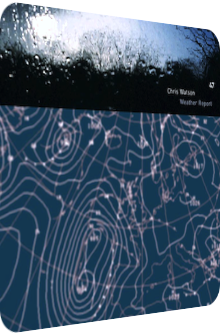
Chris Watson
Weather Report
2003
Once more, I am reviewing an album that could be put into both genre sections of this website. Chris Watson, founding member of Cabaret Voltaire and later member of the experimental Avantgarde band The Hafler Trio, is now a well-known recordist out in the vast fields, steppes and glaciers all over the world. He is always on the run and tries to capture the beauty of nature's wildlife by use of his high quality field recording equipment. Weather Report is considered his best work and got him many new fans. It is also featured in the Guardian's list of 1000 albums to hear before you die, quite an achievement for an album that consists of no musical element at all, but in fact features 3 long field recordings. What sounds like an easy-to-do task – buying a plane ticket, packing your equipment, reaching your destination via roadway, press the red dot on your recorder – is, on the contrary, another astonishing hallmark, for Watson didn't record the noises and surroundings of luxury hotels or marinas, but chose to visit 3 exotic and far-flung destinations: The Masai Mara nature reserve in Kenya, the Lapaich range of mountains in Scotland, and finally the destination that got him the attention by the press he deserves, the Icelandic Vatnajökull Glacier. Watson's approach is that of a window of opportunity: he records material of several hours, edits his selections slightly and compresses the results to resemble leaps in time. The attraction of these field-recordings is fourfoldly: firstly, Watson visits attractively foreign places that we cannot access all too easily. Secondly, the sound quality is so awe-inspiring that the clichéd quote "it sounds so realistic as if you were there in person" fits strikingly here. Thirdly, there is no pesky narrator who describes what you see and hear, as it is all too common in nature documentaries, and so, the listener can enjoy the presented vistas in all their glory. And lastly, the appeal of Weather Report lies in the missing music. There's just nature; gurgles of water, chilly winds, buzzing insects and occasional animal surprises.
The first field recording Ol-Olool-O that, according to the liner notes, was recorded for 14 hours in Kenya's Masai Mara nature reserve, starts with a striking sound: instead of a slow fade-in of birds or insects, a cattle is groaning vibrantly. It is only thereafter that insects, birds and Kenyan shepherds can be heard. After 5 and a half minutes, the first wind gusts can be heard, the insects get quieter, and sure enough, distant thundershowers cause artiodactyl-related nervousness. Finally, the rain sets in right where Watson is standing, and forms a great décor of remote thunders and croaking frogs. The last four minutes of Ol-Olool-O can be best described as curious: formerly crystal clear sounds become muffled rolls of thunder as if Watson is now inside a container, a far-away house or a similarly enclosing area. The second field recording is called The Lapaich and was recorded in Scotland during four months, from September till December, resulting in the biggest time compression in 18 minutes. It starts with dinning winds and Watson's steps through rivulets. A large cascade is near, and the familiar chirping of birds builds a harmonious backdrop to the ubiquitous, minute-long rushing water. After four minutes, the recording changes and now features increasingly stormy, fluttery winds and the cries of birds, possibly storks. Later on, squalls of rain arrive and clamouring cattle or deer express their disapproval. This field recording ends with quieter, more distant winds and cawing ravens. The final field recording is the standout track called Vatnajökull, which delivers a range of crackling, icy noises not many people have heard in such a way: Watson is deep in the diffractive Vatnajökull Glacier in Iceland, and distant winds and the constant crepitation emphasize the majestically gelid splendor of Nature. After 5 minutes, the strangest wind noises can be heard, almost sounding like music coming out of a weirdly tweaked organ or flute. Later on, the winds decrease and the cries of curious birds are audible. Soon after, Watson enters a glacial cavern once again, while at the end of the album, the majestic mood suddenly changes to a lively, bustling one, as the listener finds him- or herself in-between a huge flock of birds with a permanent stream of flowing water. The last minutes features the familiar crackles of ice that fade-out and close the album.
We all know the shedloads of CD's and downloadable apps full of whale songs, dolphin prattles, ocean waves and rain forest sceneries. Mentioning Weather Report in line with this welter is an insult to Chris Watson, for his album doesn't rely on repeated 30-second loops, but aurally displays the idea of an interplay of two forces – weather and time – in a compressed form. As such, developments take place in each field recording; rain clouds appear, insects show up, flows of water increase, cold inflation pressure rises, and so on. Watson's slight edits really do tell the story of time and the interchange between weather and its effects on flora and fauna. Lots of field recordings existed before and lots of rain drop apps were created after its release, but Watson's field recordings rise above all of them. As such, Weather Report is highly recommended and entirely different from other field recordings and everything else in one's collection for sure.
Ambient Review 019: Chris Watson – Weather Report (2003). Originally published on Dec. 28, 2011 at AmbientExotica.com.
